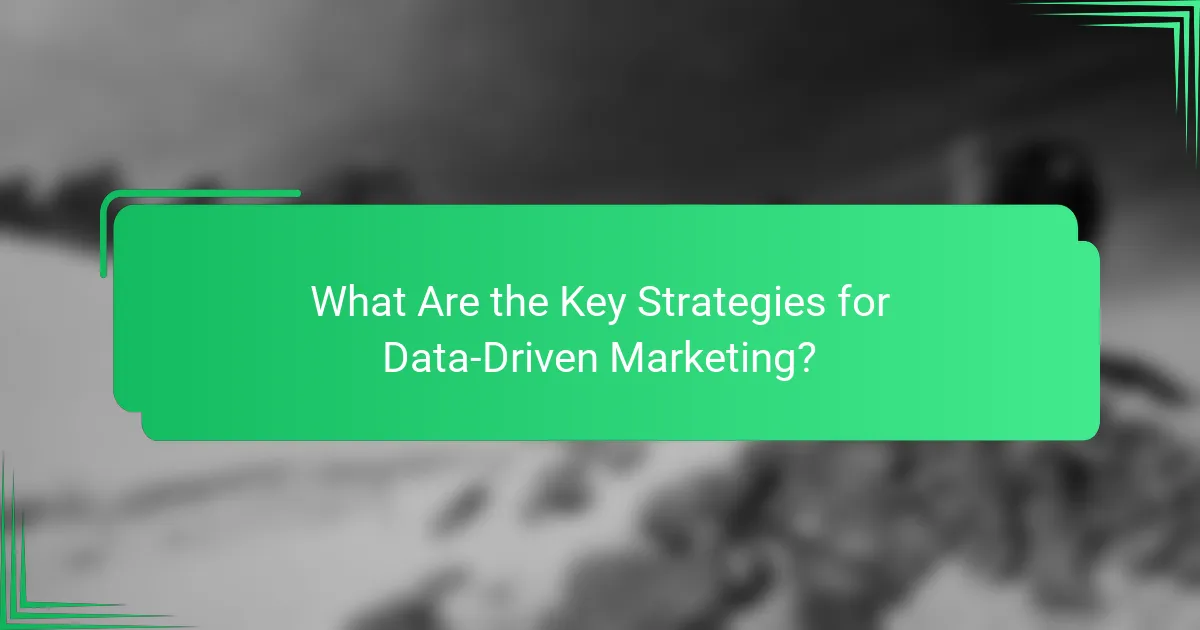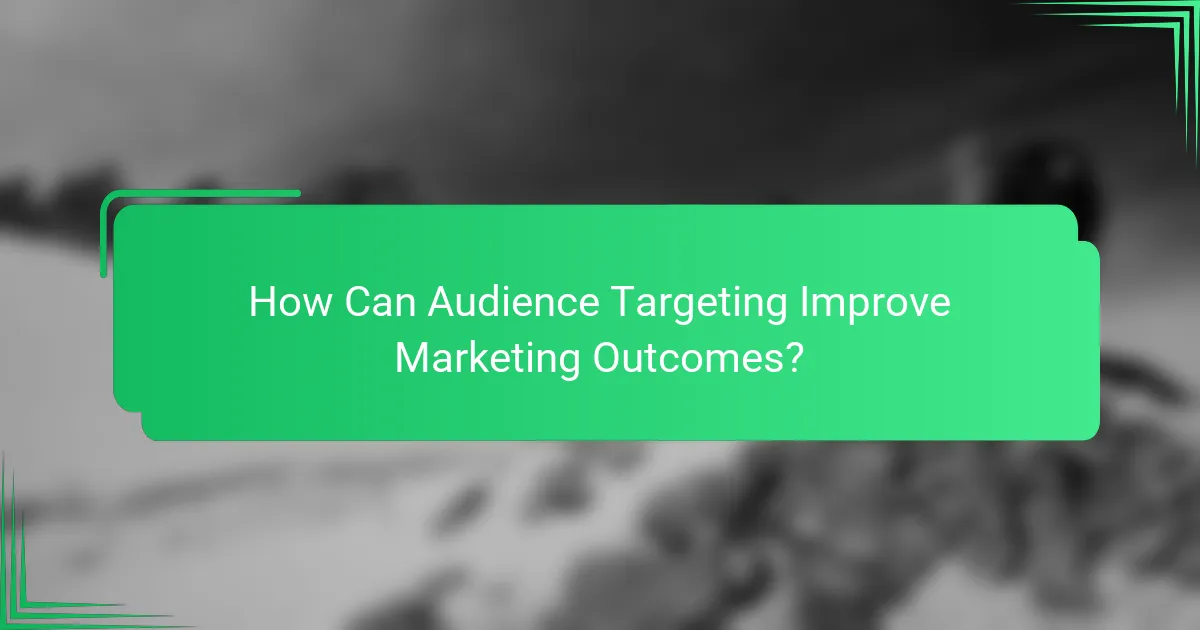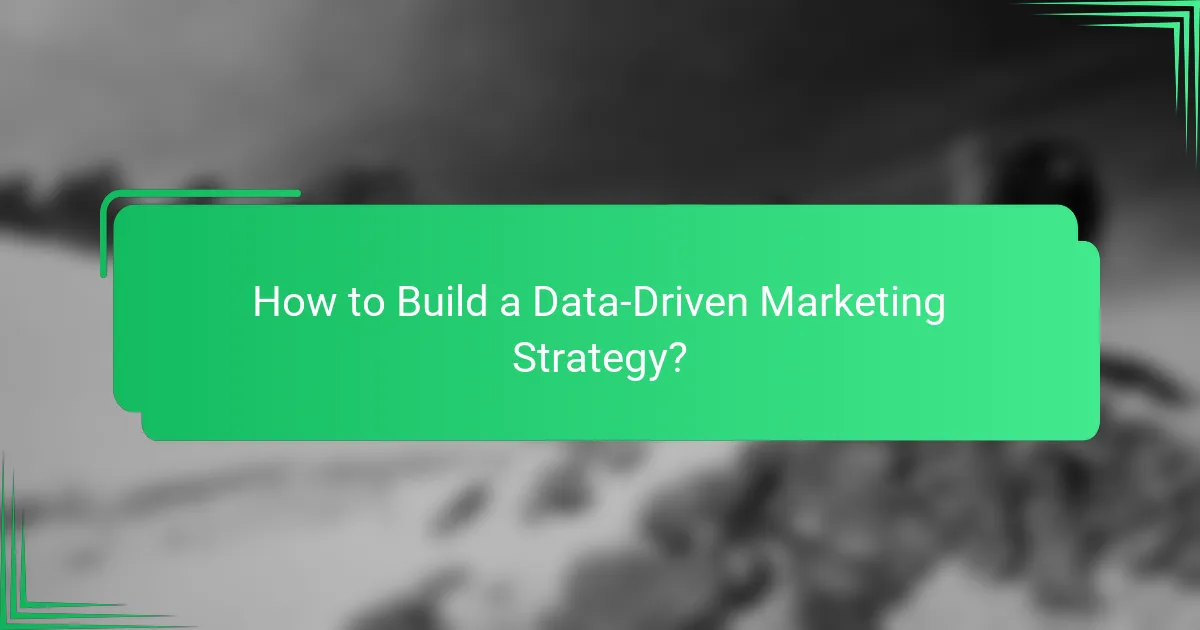Data-driven marketing leverages customer data analysis to refine strategies that boost engagement and conversion rates. By employing techniques such as customer segmentation and personalized content delivery, businesses can effectively target their audiences, ensuring that marketing messages resonate with the right consumers for improved campaign outcomes.

What Are the Key Strategies for Data-Driven Marketing?
Data-driven marketing relies on analyzing customer data to inform strategies that enhance engagement and conversion rates. Key strategies include customer segmentation, personalized content delivery, predictive analytics, A/B testing, and multi-channel integration.
Customer segmentation
Customer segmentation involves dividing your audience into distinct groups based on shared characteristics such as demographics, behaviors, or interests. This allows marketers to tailor their messages and offers to specific segments, improving relevance and effectiveness.
To implement effective segmentation, consider using data sources like purchase history, website interactions, and social media engagement. Tools like CRM systems can help manage and analyze this data efficiently.
Personalized content delivery
Personalized content delivery means creating and distributing content that resonates with individual customers based on their preferences and behaviors. This approach enhances user experience and can significantly boost engagement rates.
Utilize data from previous interactions to inform content strategies. For example, if a customer frequently browses a specific product category, send them tailored recommendations or exclusive offers related to that category.
Predictive analytics
Predictive analytics uses historical data and algorithms to forecast future customer behaviors and trends. This strategy enables marketers to make informed decisions about targeting and resource allocation.
Consider employing tools that analyze customer data to identify patterns, such as likelihood to purchase or churn. This insight can help prioritize marketing efforts and optimize campaigns for better results.
A/B testing
A/B testing, or split testing, involves comparing two versions of a marketing asset to determine which performs better. This method allows marketers to make data-driven decisions based on actual user responses.
When conducting A/B tests, focus on one variable at a time, such as email subject lines or landing page layouts, to isolate the effects. Aim for a sample size that provides statistically significant results, typically in the hundreds or thousands, depending on your audience size.
Multi-channel integration
Multi-channel integration refers to the coordinated use of various marketing channels to create a seamless customer experience. This strategy ensures that messaging is consistent across platforms, enhancing brand recognition and customer loyalty.
To achieve effective integration, map out customer journeys across channels like email, social media, and websites. Use analytics tools to track performance and adjust strategies based on customer interactions across these touchpoints.

How Can Audience Targeting Improve Marketing Outcomes?
Audience targeting enhances marketing outcomes by ensuring that messages reach the most relevant consumers, leading to more effective campaigns. By analyzing data on customer behavior and preferences, businesses can tailor their marketing strategies to resonate with specific segments, ultimately driving better results.
Increased engagement rates
Targeted marketing campaigns often see increased engagement rates because they deliver content that aligns with the interests and needs of the audience. For instance, personalized emails that address individual preferences can lead to higher open and click-through rates compared to generic messages.
To maximize engagement, consider segmenting your audience based on demographics, purchase history, or online behavior. This allows for more relevant messaging, which can significantly boost interaction levels.
Higher conversion rates
Effective audience targeting can lead to higher conversion rates by presenting the right offers to the right people at the right time. When consumers receive tailored promotions that match their interests, they are more likely to make a purchase.
Utilize A/B testing to refine your targeting strategies. By experimenting with different messages or offers for specific segments, you can identify what resonates best and optimize your campaigns for better conversion outcomes.
Enhanced customer loyalty
Audience targeting fosters enhanced customer loyalty by creating a more personalized experience. When customers feel understood and valued through tailored communications, they are more likely to develop a strong connection with the brand.
Implement loyalty programs that reward repeat customers based on their preferences and purchasing behavior. This not only encourages repeat business but also strengthens the relationship between the customer and the brand, leading to long-term loyalty.

What Tools Are Essential for Data-Driven Marketing?
Data-driven marketing relies on various tools that help businesses analyze consumer behavior, track campaign performance, and optimize strategies. Essential tools include analytics platforms, customer relationship management systems, data visualization software, and email marketing services.
Google Analytics
Google Analytics is a powerful tool for tracking website traffic and user behavior. It provides insights into how visitors interact with your site, including metrics such as page views, bounce rates, and conversion rates. By setting up goals and e-commerce tracking, businesses can measure the effectiveness of their marketing campaigns.
To maximize its potential, regularly review your analytics dashboard to identify trends and areas for improvement. Utilize features like audience segmentation to tailor your marketing efforts based on user demographics and behavior.
HubSpot
HubSpot is an all-in-one marketing platform that combines CRM, email marketing, and content management. It allows businesses to manage customer interactions and automate marketing tasks, making it easier to nurture leads and analyze campaign performance. The platform’s reporting tools provide valuable insights into customer engagement and sales funnels.
To effectively use HubSpot, take advantage of its lead scoring system to prioritize high-value prospects. Regularly update your contact lists and segment your audience for targeted campaigns, which can improve conversion rates significantly.
Tableau
Tableau is a leading data visualization tool that helps marketers turn complex data into easily understandable visuals. It allows users to create interactive dashboards and reports that can highlight key performance indicators and trends. This visual representation aids in making data-driven decisions quickly.
When using Tableau, focus on creating clear and concise visualizations that tell a story. Regularly update your data sources and ensure your dashboards are user-friendly to facilitate collaboration among team members.
Mailchimp
Mailchimp is a widely used email marketing service that enables businesses to create, send, and analyze email campaigns. It offers features such as audience segmentation, A/B testing, and performance tracking, which are essential for optimizing email marketing efforts. The platform’s automation capabilities help streamline communication with customers.
To enhance your Mailchimp campaigns, segment your audience based on behavior and preferences to deliver personalized content. Monitor key metrics like open rates and click-through rates to refine your strategies and improve engagement over time.

What Metrics Should Be Tracked in Data-Driven Marketing?
In data-driven marketing, tracking key metrics is essential for evaluating campaign effectiveness and optimizing strategies. Focusing on metrics like ROI, CAC, and CLV provides insights into financial performance and customer behavior.
Return on investment (ROI)
ROI measures the profitability of marketing investments relative to their costs. It is calculated by dividing the net profit from a campaign by the total costs, then multiplying by 100 to get a percentage. A positive ROI indicates that the marketing efforts are generating more revenue than they cost.
When assessing ROI, consider both short-term and long-term impacts. For instance, a campaign may yield immediate sales but also build brand awareness that pays off later. Aim for an ROI of at least 20-30% to ensure your marketing strategies are effective.
Customer acquisition cost (CAC)
CAC represents the total cost of acquiring a new customer, including marketing expenses, sales team costs, and any other related expenditures. To calculate CAC, divide the total costs associated with acquiring customers by the number of new customers gained in a specific period.
A lower CAC is preferable, as it indicates more efficient marketing efforts. Businesses should aim for a CAC that is significantly lower than the CLV to ensure profitability. Regularly reviewing and optimizing your marketing channels can help reduce CAC over time.
Customer lifetime value (CLV)
CLV estimates the total revenue a business can expect from a single customer throughout their relationship. It is calculated by multiplying the average purchase value, purchase frequency, and customer lifespan. Understanding CLV helps businesses determine how much they can afford to spend on acquiring customers.
To maximize CLV, focus on customer retention strategies, such as loyalty programs or personalized marketing. A strong CLV can justify higher CAC, as it indicates that customers are likely to generate significant revenue over time. Aim for a CLV that is at least three times higher than your CAC for a sustainable business model.

How to Build a Data-Driven Marketing Strategy?
Building a data-driven marketing strategy involves using data analytics to inform decisions and optimize marketing efforts. This approach enhances targeting, improves customer engagement, and increases return on investment (ROI).
Define objectives
Clearly defining objectives is the first step in creating a data-driven marketing strategy. Objectives should be specific, measurable, achievable, relevant, and time-bound (SMART). For example, an objective could be to increase website traffic by 20% over the next quarter.
Consider aligning your marketing goals with overall business objectives. This ensures that your data-driven efforts contribute to broader company success, such as boosting sales or improving customer satisfaction.
Collect relevant data
Collecting relevant data is crucial for informing your marketing strategy. Focus on gathering data from various sources, including customer interactions, website analytics, social media metrics, and market research. Tools like Google Analytics and CRM systems can help streamline this process.
Ensure that the data you collect is accurate and up-to-date. Regularly review your data sources and methodologies to maintain quality. Additionally, be aware of privacy regulations, such as GDPR in Europe, which govern how you can collect and use customer data.


